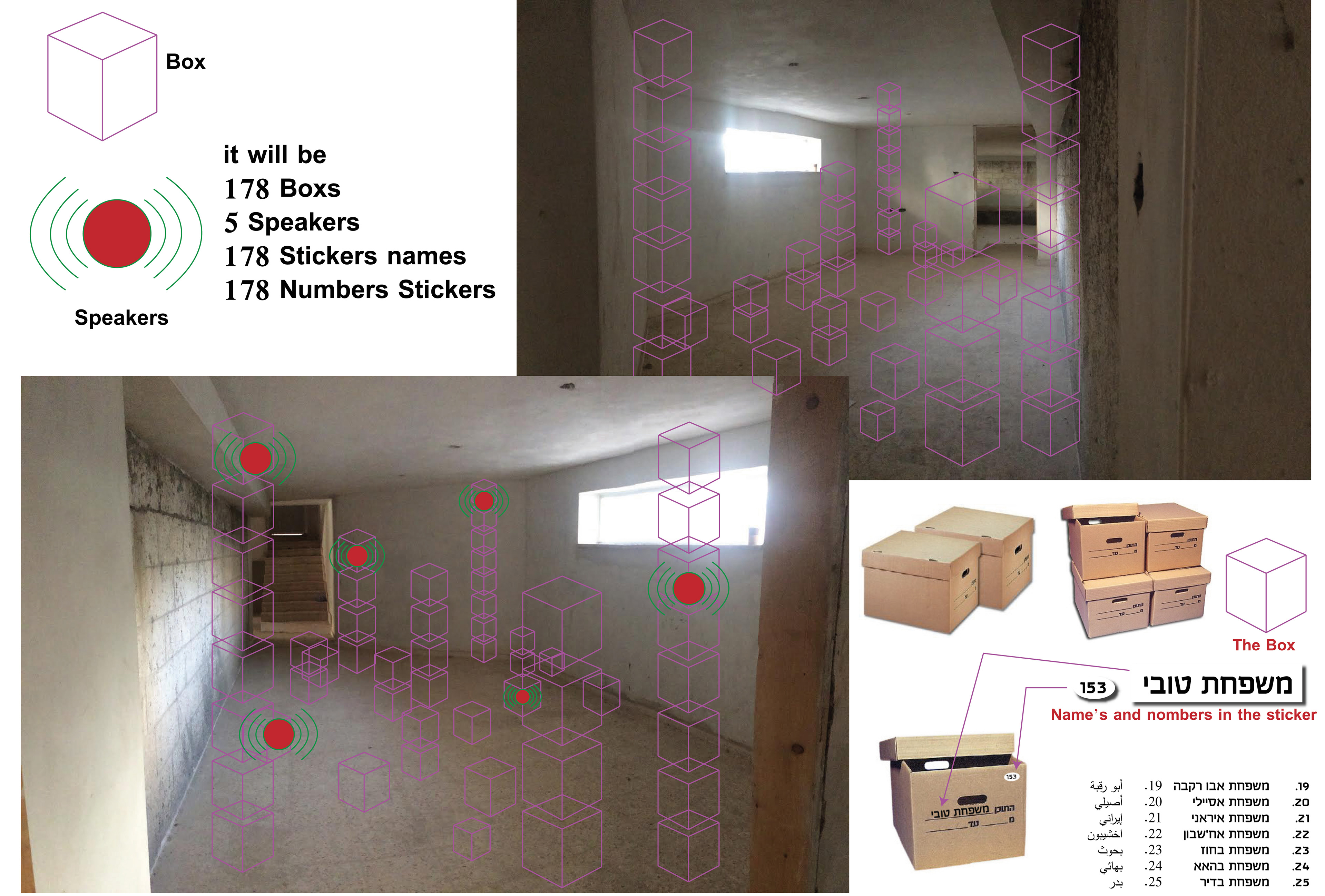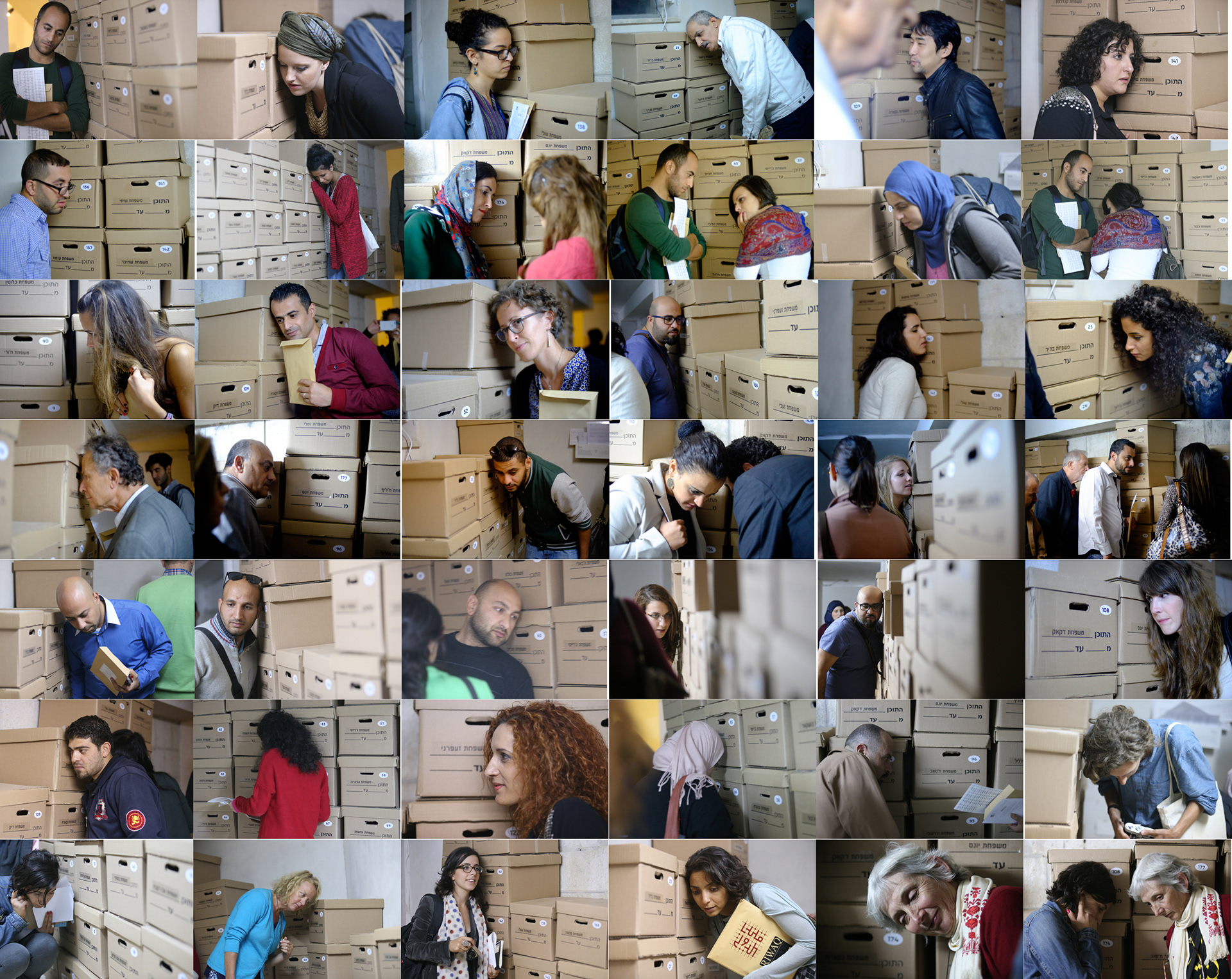Wadi Nisnas 2014
Description:
The installation is a room with archives. The archives are displayed as 178 boxes with the names of the families in Hebrew. The Hebrew depicts lack of identity. The Hebrew names represent identities taken by Israel that have turned them into a mere history while erasing their presence. The boxes are arranged in the middle of the room. The visitor of the exhibition must walk through the room and listen to the interviews that are recorded with shared memories. There is no order to the stories; they are randomized depending on where you stand; similar to the unorganized matter of Wadi Nisnas. There are five speakers in five boxes that are scattered in the room.

Installation: Wadi Nisnas
As a result of the Nakbeh and the Zionist occupation of Haifa, thousands of Palestinians were forced out of Haifa after 1948. The newly formed Israeli government placed the Arab residents of Haifa in a small confined area at the very bottom of Haifa, which is called “Wadi el Nisnas,” a very small segment of what used to be Haifa’s historical old city which was mostly gentrified and transformed into the larger modern and industrialized Israeli Haifa. The neighborhood quickly transformed into a human ghetto, consisting of small buildings piled up on top of each other with no organized infrastructure surrounded by a market place and food stands owned by the neighborhood’s residents. Towards the late 1950’s, approximately 2000 Palestinians lived in the area until the presence of Jewish immigration to Palestine from other Arab countries.
As a result of spending my childhood and life in Wadi Nisnas and my familiarity with the people of the neighborhood, I was able to interview dozens of Palestinians from Wadi Nisnas in order to understand their stories. I began to understand the social difficulties that they face, and ones that I was a part of as well. There was a strong message of people who battled to understand their true identity; whether it included the disappearance of their own Arabic language from the neighborhood or the disappearance of their cultural history leading to a tragic loss of hope and optimism.
My project aims to shed light on some of the anecdotes that I came across in my interviews. These conversations were recorded and connected in order to form a full narration in the form of memory flashbacks that slowly disappear and fade away into what exists today. Today, as residents face endless racist policies and a system of obvious ethnic segregation, it is important to remember those who the occupation attempted to erase from history over 50 years ago.
The Installation will be designed in the following way: [WADI NISNAS]
The installation will be a room that contains archives. The archives will be displayed as boxes with the names of families in Hebrew. These names will depict that lack of care of the citizens of Wadi Nisnas and their identity. The Hebrew names will represent identities that are “stored” in Israeli warehouses that have taken over the Palestinian narrative and have turned them into a mere history while erasing their presence today.
The boxes will be arranged in the middle of the room. The visitor of the exhibition will walk through the room and hear the interviews that I recorded and the stories that were shared of memories of the neighborhood. There will be no specific order to the stories; they will be randomly placed depending on where the individual walks to; similar to the unorganized matter that Wadi Nisnas is built. Earphones will be available on each box so that the listener can hear and understand the story.

File A :
1. In the 18th century, according to [speaker], Haifa was no more than a sailors’ village.
2. In the 1770s, we were already here, we were sailors. Habib came across the sea, from Dar El-Amar through Tyre [Lebanon], back in 1773. He was also a sailor, his house was located further down, next to Simon Haddad (or Shh’eibar).
* Street Sounds *
3. Very few people stayed [in Haifa], and those who came later were refugees from Fasouta, Meilya, Tarsheha, Tora’an, Nazareth, Tamra and the entire Galilee, Muslims and Christians. That’s how the Arab population grew in Haifa, and took over almost fifty per cent of the Arab buildings. Eben Sina St., Qesarya St. and Hertzel St. are full of Arab architecture, and further up at the end of Herzel St. is where all the religious people live.
4. Back then, Arab citizens lived proudly; they had everything they needed. Unlike the Jews, who came from the kibbutz looking like gypsies in their dirty clothes, the Arabs wore nice suits and looked good. I remember all this. Even their minister wore filthy clothes.
1. In the 18th century, according to [speaker], Haifa was no more than a sailors’ village.
2. In the 1770s, we were already here, we were sailors. Habib came across the sea, from Dar El-Amar through Tyre [Lebanon], back in 1773. He was also a sailor, his house was located further down, next to Simon Haddad (or Shh’eibar).
* Street Sounds *
3. Very few people stayed [in Haifa], and those who came later were refugees from Fasouta, Meilya, Tarsheha, Tora’an, Nazareth, Tamra and the entire Galilee, Muslims and Christians. That’s how the Arab population grew in Haifa, and took over almost fifty per cent of the Arab buildings. Eben Sina St., Qesarya St. and Hertzel St. are full of Arab architecture, and further up at the end of Herzel St. is where all the religious people live.
4. Back then, Arab citizens lived proudly; they had everything they needed. Unlike the Jews, who came from the kibbutz looking like gypsies in their dirty clothes, the Arabs wore nice suits and looked good. I remember all this. Even their minister wore filthy clothes.
File B :
The room number was 64 at Shemen. There were two buildings that belonged to the IPC [Iraq Petroleum Company]. They used to bring us food. We used to eat, sleep and work there. Immediately after hearing that the Al-waad neighbourhood (Wadi Nisnas) was finally safe and secure, me and my father bought a house there. It was at 12 Al-Wadi St.
2b. * Ship’s Horn *
They hid him in Mar-Elias neighbourhood for six months...
then the government gave the Jews all the houses that belonged to the Arab refugees. And dropped all the Arabs in the “Waad” (Wadi Nisnas) neighbourhood. “Waad” became like Qesarya St., half Arabs/half Jews. Al-Wadi St. was half Arabs/half Jews, all the way down to Mario Hanna St. My father built this iron window. The government locked my father in Al-waad neighbourhood with all the other families.
then the government gave the Jews all the houses that belonged to the Arab refugees. And dropped all the Arabs in the “Waad” (Wadi Nisnas) neighbourhood. “Waad” became like Qesarya St., half Arabs/half Jews. Al-Wadi St. was half Arabs/half Jews, all the way down to Mario Hanna St. My father built this iron window. The government locked my father in Al-waad neighbourhood with all the other families.
Half of the shops in Wadi Nisnas were given to the Jews who came from Europe. Next to the “Arab Bakery” there were two boutiques. These two shops were given to two Romanian Jews in the 1950s. One sold only apples, and the other sold only bananas.
4b. * Street Sounds / Church Bells *
File C :
1. When he came back in 1951 he went to check on his house, knocked on the door and a lady named Haya Hava, or whatever, opened the door, speaking Arabic with a Jewish accent, saying: “What do you want, habibi?”
He replied: “The house!”
She said: “Go ask for it from the government.”
Then he said: “At least my stuff?”
She replied with the same answer: “Go to the government.”
“At least give me my oud back. My father bought this oud from Majeda El-Romi’s grandfather, it’s a handmade oud that was built specially for my father because he’s left-handed.”
2c. * Playing the Oud *
2. There was a Moroccan Jewish family who moved to Wadi-Saleeb, by the market.
3. From 1948 until 1951, Jews were coming from North Africa and eastern Europe. Our neighbours were Romanian Jews, and on the last floor were Jews from Sham (Syria).
3. From 1948 until 1951, Jews were coming from North Africa and eastern Europe. Our neighbours were Romanian Jews, and on the last floor were Jews from Sham (Syria).
6. When I left school in 1957, I remember we had Egyptian Jewish neighbours, and even from Lebanon, and they didn’t speak one word of Hebrew, only Arabic.
7. You speak Arabic, as well as your brother, your father and your mother speaking Arabic, and the next morning you wake up speaking only Hebrew?! How does that happen?!
7. You speak Arabic, as well as your brother, your father and your mother speaking Arabic, and the next morning you wake up speaking only Hebrew?! How does that happen?!
File D:
An old man speaking:
“I used to speak broken Hebrew, didn’t know the male, female referents. Some Jewish guy approached me and said, ‘We also can’t speak Hebrew very well, don’t be afraid to speak, someone will help and correct you.’ That’s how I learned Hebrew. Abu-Hatab, a sailor who was responsible for bringing the Jews from Lebanon and Aleppo [Syria], used to come every Thursday. My cousin and I used to help him by the shore at Ras-Elnaqoka (Rosh Hanekra). The manager gave us orders to help him, while the other Jews didn’t help at all. All the immigrants first had to go through registration, then through sprayers that sprayed them with DDT, and leave the area in trucks.”
File E :
From the day you’re born, you’ll carry tons of weight, and by tons of weight I mean judgments (by the government), your lost nationality and more.
2E. * Wind Sound *
Cinema, the playgrounds, going back home and listening to stories from the elders, especially those who were from out of town.
3E. * Ambient Crowd Noise *
Cinemas close to the Wadi Nisnas neighbourhood… there was one… two… three… four… eight. After ’48, there was only one cinema that showed Arabic movies, the Ganim cinema, where the city centre mall is now. And where Um Kulthum and Farid Al-Atrash (classical Tarab singers) performed in Cinema Ein-Dor, it shows Hollywood movies now like Hercules and that stuff.
We used to watch the girls from a distance, we loved them secretly. They used to play girls’ games and the boys played more physical games.
3E. * Ambient Crowd Noise *
“As real as the dew on the tree leaves, your name is in my heart like a prayer to the sky.” That’s not a love song, that’s a song for Palestine.